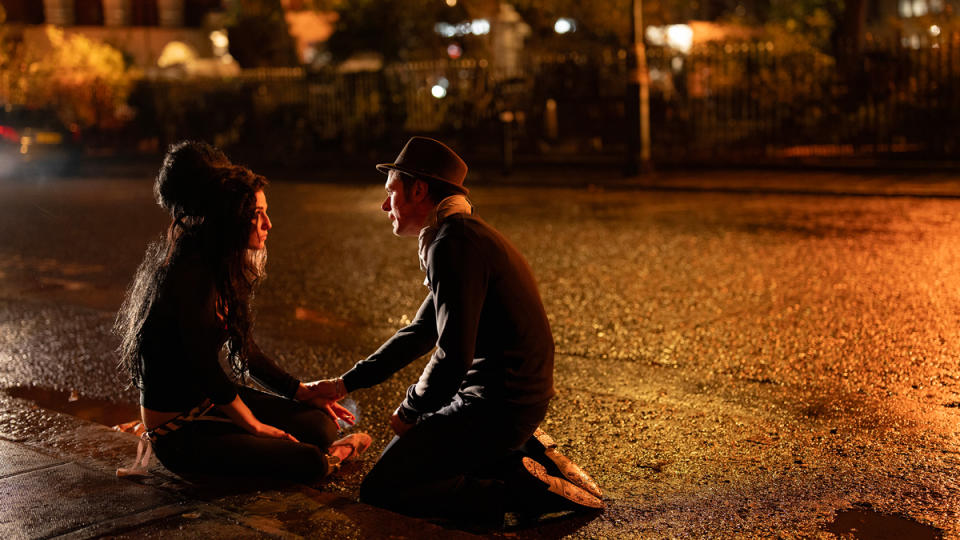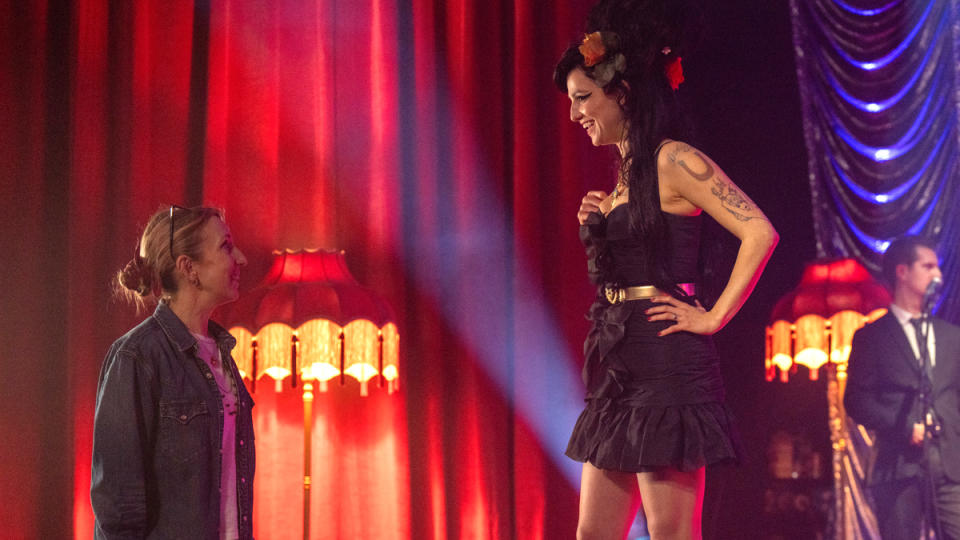For the Director of Back to Black, Finding the Right Amy Winehouse Was the Easy Part
- Oops!Something went wrong.Please try again later.
- Oops!Something went wrong.Please try again later.
- Oops!Something went wrong.Please try again later.
The post For the Director of Back to Black, Finding the Right Amy Winehouse Was the Easy Part appeared first on Consequence.
The new film Back to Black, made with the involvement of the Amy Winehouse estate, tracks the rise of the genre-defying singer-songwriter prior to her death at the age of 27. Her Grammy wins, her drug and alcohol abuse, and her intense relationships are all central to the story, but when asked about tackling this very specific subgenre of film, director Sam Taylor-Johnson tells Consequence that she “didn’t want to make a music biopic.”
As the director behind films including Nowhere Boy and 50 Shades of Grey explains, “I didn’t want to trawl through birth, through death. I felt like what I wanted to do, actually, was something quite different — which was to use Back to Black [the album] as a framework for making the movie. Although we have scenes of her younger, the bulk of the movie is within that time period. And looking at her as a creative soul through her work was the approach I wanted to take. So in that way, it’s very different from music biopics as a genre. Not to say I don’t love music biopics, but this one, I just felt like I wanted to frame it within her most creative period and understand what that was and where it came from.”
Key to that was finding the right actor to play the role, though when asked about the search for her Amy Winehouse, Taylor-Johnson laughs. “I really want to say it was like painful and tortured, but it wasn’t. The first person I met was Marisa.”
Industry star Marisa Abela wasn’t the last person the 50 Shades of Grey director met with, but as she considered other actresses, Abela was “the person through the door” for every step of the process. “I kind of instinctually knew that it was Marisa. So I want to describe this long, arduous process of a nationwide search, that I had to meet thousands and thousands [of actors], but I didn’t.”
Sitting beside Taylor-Johnson for our Zoom chat, Abela says that as an actor, the most important thing to her is “connecting to a psychological and emotional truth — the human behind everything that you do, especially when it’s an icon like Amy. I think the temptation is to play the icon and to play the mannerisms and play the voice, but you have to find the truth behind all of it, and her intentions and wants and desires. That was what I was always going to bring to any version of this if I was going to do it, and the fact that Sam responded to it meant that I was right for this part, because we were aligned in our intention with the project, which was to really expose a level of humanity in Amy that we’ve missed for a while, in the public conversation about her.”
According to the director, what sold her on Abela was that “she showed me an internal transformation which can only happen in a very few people. When you see and connect with an actor who can look you in the eye as somebody different to who walked into the room, that is what tells you they’re the person for the job. And that happened pretty much straight away in our read-through.”
Films about famous musicians usually touch on big iconic events from their lives, and for Abela, one such instance that was important to recreate was Winehouse’s Grammy win for Record of the Year.
“She just has that moment of breathlessness and complete shock and innocence and awe, which just takes her right back to that childlike, very exposed, very vulnerable woman amongst this incredible success and these huge accolades and this intense amount of fame. I think it was a moment that struck a chord with so many people for that exact reason. When I saw it in our script, I was like, ‘That is a really iconic moment. I’m going to have to get that right.'”
Taylor-Johnson, meanwhile, really wanted to capture the frenzy of paparazzi that surrounded Winehouse, especially during her relationship with eventual husband Blake Fielder-Civil (played here by Jack O’Connell). That’s because the London-based director happened to live relatively close to Winehouse during that time, and while she never saw the singer being pursued, she’d catch the aftermath: “I’d always see the paparazzi standing on the street corner going through all their pictures, talking to each other about the fact that she’d just been there.”
There was one paparazzi shot in particular that struck Taylor-Johnson, of Winehouse and Fielder-Civil “sitting on the curb of the street in SoHo, and they’ve had a fight and he’s got scratches on his face. It’s like four o’clock in the morning and they’re holding each other — it was such a powerful image at the time because I remember looking at it and seeing this couple who are intensely wildly intoxicatingly in love, and it’s being played out for us day-to-day in the tabloids.”
It’s a shot that led Taylor-Johnson to “the understanding that they were never alone. She was never alone, and everything was just for our entertainment. It is almost a horrible reality TV show of somebody’s breakdown and downfall, and that picture really summed it up for me. It always played in my head. In many respects, it’s a really powerfully romantic image of two people holding onto each other whilst the world is whirling around them and taking pictures, but at the same time, you know, it’s devastatingly sad that it’s there for us to pick apart. That was one of the pictures that I really held onto, as a crux of this story.”
While largely told in a chronological fashion, Back to Black was not shot in order. This was because in order to resemble the famous singer at her lowest points in life, Abela went through “a long process” prior to filming which included losing weight “in a way that was managed and healthy,” as Taylor-Johnson puts it. This also meant that the production schedule began “with some of the really intensely challenging scenes, where Amy is very vulnerable and very fragile.”
Says Taylor-Johnson, “Those were the first days of filming, which was incredibly challenging for everybody. But to take [Abela] to that starting place needed to be thoughtful and over months.”

Back to Black (Focus Features)
The production then essentially went backward, as Abela transformed into the younger, more optimistic Amy — “a quicker process,” Taylor-Johnson explains. “That felt like the smartest way to do it, but it was not without its challenges, as you can imagine.”
Starting with this tough material, Abela says, was “an intense emotional place to go into, but the truth with Amy is that every emotion is experienced incredibly intensely, even joy. So of course those dark scenes require a different mode of connection, and it is difficult to stay in that sort of emotional plane for a certain amount of time.”
Yet, she adds, “When [Amy] meets Blake for the first time and she’s falling in love, that requires a level of energy and presence… It’s hard to say what was more difficult than the other. In a way, I think those later scenes that we filmed first, Amy is less present. She’s more out of her own body, so that there’s an element of that that was useful. I didn’t need to be bringing the most amount of energy to set every single day. I could warm up physically with the knowledge that Amy herself is not expending much energy at this time.”
This strategy actually helped simplify maintaining the tattoo continuity, as Abela’s Amy gets more and more tatted up over the course of the film. “That kind of stuff did all go together because when I was at my smallest, that’s when I had my most amount of tattoos,” Abela says. “So they came off through the weeks, rather than came on.”

Behind the scenes of Back to Black, courtesy of Focus Features
Despite rumors that scenes with an actor playing Mark Ronson were shot, Taylor-Johnson says that she made the decision “early on” not to film such sequences. “Mark Ronson obviously was such a huge figure in her life, but the story we were telling was so specifically about her love story. And every time we tried to build in a Mark Ronson story, it didn’t feel like enough. We needed more time, more space and a bigger sort of relationship path. It was almost like I needed to add another 20 minutes to the movie.”
Abela agrees, adding that to have a figure like Ronson represented on screen for a very short period of time “feels like a bit of a gimmick as well. Mark’s a really iconic figure, he deserves his own proper portion of the film, if you were going to do it.”
So instead of making Ronson a full character in the story, Taylor-Johnson says that “I felt like the way to acknowledge Mark was to name him, with Back to Black being the thing they created. There were moments that I kept thinking, ‘I can pull him into this moment.’ But every time I did, it just didn’t serve him. I met with Mark Ronsons and no one came close to representing what he represents. It felt like sometimes what you don’t see is more powerful — so saying, you know, ‘I want you to go off and record with Mark Ronson,’ and then having a sense of that felt stronger.”
As much of a challenge as it was to recreate what was established about Winehouse’s life in the public eye, Abela notes that “it was just as difficult and there was just as much pressure to get the more imaginative moments right, just in a different way. It’s more of an imaginative leap than a technical feat, as it were.”
One such imagined scene, early in the film, features a young Winehouse sitting on her bed at home with her guitar, working on a song. “Sam does an incredible thing with that scene — it’s one long take, so you are seeing the conception of this song happen in real-time,” Abela says. “There might be little mistakes in the guitar and in the writing of it, and she might say a word that’s slightly different to the word that actually ends up in the song. But it feels so real with that one long shot. There’s a level of confidence there in our ability to tell this story — and me being Amy.”
Back to Black arrives in theaters on Friday, May 17th.
For the Director of Back to Black, Finding the Right Amy Winehouse Was the Easy Part
Liz Shannon Miller
Popular Posts

